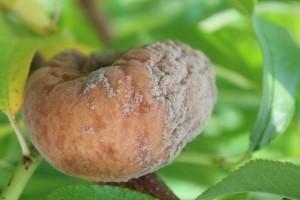Brown Rot of Peach Fruit Trees
Abundant rainfall and warm temperatures can lead to an increase in the presence of brown rot on stone fruits (peach, cherry, plum, nectarine), which results in rotten, inedible fruit. Management of this disease begins at petal fall. Early season management can reduce initial sources of the fungus as it emerges from dormancy and results in less disease incidence later in the season.
Brown Rot Facts
· Symptoms include soft, brown fruit decay (Figure 1). Twig blight and blossom blight may occur in spring.
· All stone fruits are susceptible.
· Infection can occur throughout the growing season, during harvest, and in storage.
· Fruit is more susceptible as it matures.
· Periods of warm, wet or humid weather may result in higher disease incidence.
· Caused by the fungus Monilinia fructicola.
· The pathogen overwinters on rotted fruit (mummies) (Figure 2) and blighted twigs from the previous season.

Figure 1: Peach fruit infected with brown rot. (Photo: Nicole Ward Gauthier, UK)

Figure 2: Rotted peach fruit mummy. (Photo: Molly Giesbrecht, Texas A&M AgriLife Extension Service, Bugwood.org)
Management Options
· Apply fungicides such as captan or chlorothalonil beginning at petal fall. Always follow label directions when utilizing fungicides.
· Remove and discard decayed fruit and mummies as soon as possible.
· Prune and discard blighted twigs after harvest.
· Avoid fruit injury (e.g., from insects or damage during harvest).
· Increase air movement in tree canopy by selective pruning to speed drying after rain events.
Greg Drake II
Butler County Kentucky Extension Agent for Agriculture and Natural Resources
Philanthropy Director, Kentucky Association of County Agriculture Agents
270-526-3767



























